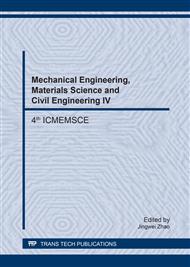p.57
p.62
p.71
p.77
p.81
p.89
p.95
p.100
p.105
Effect of Calcination Heating Rate on Microstructure and Performances of NSR Catalyst
Abstract:
The Be/Ce/γ-Al2O3 compound catalysts were prepared by sol-gel process using γ-Al2O3, Ba (AC)2 and Ce (NO3)3·6H2O as raw materials, and the effect of calcination heating rate on microstructure and performance of the NOx storage and reduction (NSR) catalyst was investigated. The crystal structure, microstructure, absorption and reduction performances of the NSR catalyst were characterized and analyzed by X-Ray diffractometer (XRD), scanning electron microscope (SEM), energy dispersive spectrometer (EDS), Brunauer Emmett Teller (BET) and H2 temperature program reduction (H2-TPR). The experimental results show that the Ba and Ce elements mainly exist in the forms of BaCO3 and CeO2, respectively, and partial CeO2 is amorphous. The calcination heating rate can play a key role in the grain size and distribution of BaCO3 and CeO2, so that it can affect the surface area, pore volume and pore diameter of the NSR catalyst. Moreover, the reduction temperature of the NSR catalyst decrease first and then increase with the increase of calcination heating rate, and the reduction temperature of as-received NSR catalyst is the lowest as the reduction temperature is 6 °C/min, that is its reduction performance is the optimal.
Info:
Periodical:
Pages:
81-85
Citation:
Online since:
March 2017
Authors:
Price:
Сopyright:
© 2017 Trans Tech Publications Ltd. All Rights Reserved
Share:
Citation:


